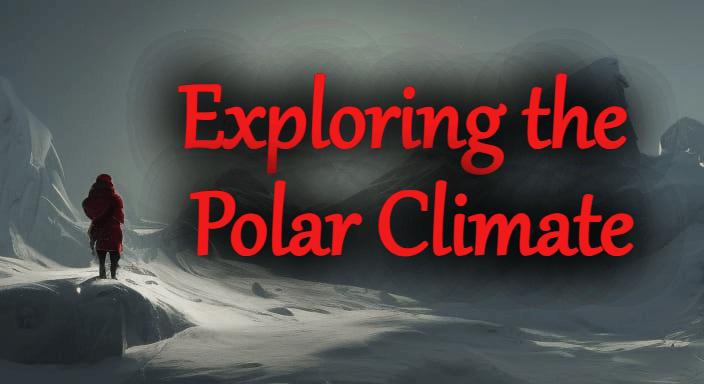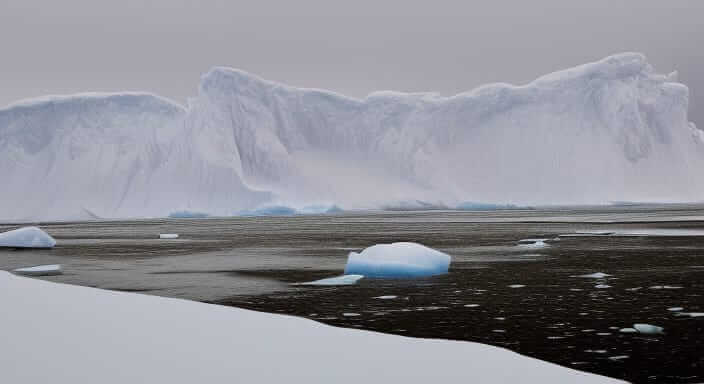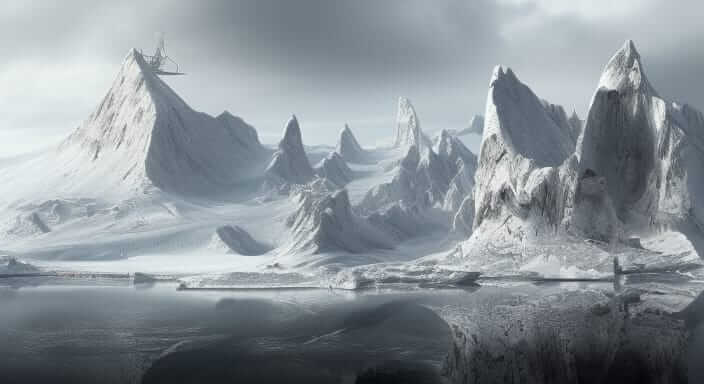Discover the defining features of the polar climate, from extreme cold temperatures to unique ecosystems. Learn about polar regions’ distinct characteristics in this informative post.

Cold climates can be subdivided into:
- Cold continental climate. It is found in the north and northwest of Europe, Canada, Alaska and south and central Siberia.
- Tundra climate. It occurs in much of Siberia, part of the Arctic and Antarctic continent.
- Polar climate. It is present only in the Arctic and Antarctic.
Mountainous climate. They are found in mountain areas where the peaks exceed 2,000 meters (near the poles) or 3,500 meters in areas near the equator.
Polar weather description
The polar or frigid climate is found within cold climates and is characterized by scarce rainfall and temperatures below 0 ° C with a low percentage (or zero) of humidity.
Characteristics Of Polar Climate
1. Location
The polar climate is characterized by extremely cold temperatures and unique environmental conditions. Here are some key characteristics of the polar climate in terms of location:
- Geographical Location: The polar climate is found near the Earth’s poles, specifically within the Arctic and Antarctic regions. The Arctic is located around the North Pole, encompassing areas such as Greenland, parts of Canada, Russia, and Scandinavia. The Antarctic, on the other hand, is situated around the South Pole and includes the continent of Antarctica.
- High Latitude: Polar climates are associated with high latitudes. The Arctic Circle marks the approximate boundary of the polar climate in the Northern Hemisphere, while the Antarctic Circle defines the boundary in the Southern Hemisphere. These circles are located at approximately 66.5 degrees north and south latitudes, respectively.
- Sunlight and Darkness: Polar regions experience extreme variations in daylight and darkness throughout the year. During winter, the polar regions have prolonged periods of darkness, often referred to as polar nights, where the sun does not rise above the horizon. Conversely, during summer, there are extended periods of continuous daylight, known as the midnight sun, where the sun remains above the horizon for 24 hours.
- Cold Temperatures: The polar climate is known for its frigid temperatures, which remain low throughout the year. Winters are exceptionally cold, with average temperatures well below freezing, often dropping to minus 30 degrees Celsius (-22 degrees Fahrenheit) or lower. Summers are relatively short and still quite chilly, with average temperatures rarely exceeding 10 degrees Celsius (50 degrees Fahrenheit).
- Permafrost: Permafrost, which refers to permanently frozen ground, is a significant characteristic of polar regions. The soil, rocks, and subsoil in polar areas remain frozen year-round, creating unique challenges for vegetation growth and infrastructure development.
- Ice and Snow: Polar climates are synonymous with ice and snow. Large areas of the polar regions are covered by ice sheets, glaciers, and snow throughout the year. The Arctic is home to the Arctic Ocean, which has a vast expanse of sea ice that varies in extent throughout the seasons. Antarctica, on the other hand, is predominantly covered by an ice sheet that is several kilometers thick.
- Strong Winds and Storms: Polar regions often experience strong winds and storms, contributing to the harsh and inhospitable conditions. These winds, known as katabatic winds, result from the flow of cold, dense air from higher elevations to lower elevations, causing rapid wind speeds and wind chill effects.
It’s important to note that these characteristics can vary between the Arctic and Antarctic regions due to differences in geography, landmass, and oceanic influence.
2. Temperatures
The polar climate is known for its extremely cold temperatures. Here are some key characteristics related to temperatures in polar regions:
- Low Average Temperatures: The polar climate experiences consistently low average temperatures throughout the year. In winter, temperatures often drop well below freezing, reaching extreme lows of -30 degrees Celsius (-22 degrees Fahrenheit) or even colder. Even during the brief summer season, temperatures remain relatively cool, rarely exceeding 10 degrees Celsius (50 degrees Fahrenheit).
- Seasonal Temperature Variations: Polar regions have distinct seasons, but the variations in temperature between seasons are relatively small compared to other climate zones. Winters are the coldest, while summers are the mildest, but the temperature range is limited due to the proximity of the poles to the Earth’s axis.
- Temperature Inversions: Temperature inversions are common in polar climates. Normally, air temperatures decrease with increasing altitude, but in temperature inversions, a layer of warmer air sits above a layer of colder air near the ground. This inversion traps cold air near the surface, contributing to the stability and coldness of the polar climate.
- Wind Chill: Wind chill is a significant factor in polar regions. Even when temperatures are relatively moderate, the effect of cold winds can make it feel much colder. Strong winds, especially katabatic winds that flow downslope from higher elevations, can intensify the chilling effect and make the ambient temperatures feel even colder.
- Polar Night and Midnight Sun: Polar regions experience periods of continuous darkness and continuous daylight due to their high latitudes. During the winter months, the polar regions go through a period called the polar night, where the sun remains below the horizon for 24 hours, resulting in no daylight. Conversely, during the summer months, the polar regions experience the midnight sun, with the sun above the horizon for 24 hours, leading to continuous daylight.
- Diurnal Temperature Range: In polar regions, the diurnal (daily) temperature range can be quite small. During the coldest parts of winter, temperatures may remain relatively stable throughout the day, with little fluctuation. In contrast, during the summer months, the diurnal temperature range can be slightly larger, but it is still relatively narrow compared to other climate zones.
It’s important to note that the specific temperature characteristics can vary between the Arctic and Antarctic regions due to differences in geography, oceanic influences, and ice cover. However, the overall coldness and harshness of the polar climate are common to both regions.
3. Seasons
Although the 4 seasons of the year correspond to classification parameters, the truth is that in areas such as the Arctic or the Antarctic, these 4 stations are not present (tangibly). Rather, there are two seasons where the winter is extremely cold and extensive, while the temperatures in the summer months do not exceed 10 ° C.
4. Inclination of the Earth
Because of the angle of inclination of the Earth with respect to these 2 poles, the days and nights last for 6 months. That is to say, while in the North Pole six months pass without the sun being hidden (rather it borders the horizon line), in the South Pole the sunlight does not arrive during this time.

5. Precipitation
The precipitations are practically null (around 300 mm annual) and always fall in solid form (snowflakes).
6. Winds
There are strong winds called nevazón or blizzards that are characterized by the presence of storms with strong winds loaded with snow.
7. Landscape
The type of landscape at the poles is white, thanks to snow and ice.
8. Polar climate flora
Since the soil is mostly frozen, the presence of plant life is difficult. However, in times of temperate temperatures mosses, lichens and small shrubs grow in certain areas.
9. Polar climate wildlife
The fauna present in the polar climate is also scarce, limited to a few mammals, birds and aquatic animals.
As a characteristic of the polar climate, the mammals of this region mostly have a white coat, in order to protect themselves from the attacks of other predators and to be devoured. Examples are the polar bear, arctic fox, arctic wolf, arctic hare and reindeer, among others.
Birds generally migrate in winter to warmer coasts. For its part, the aquatic fauna stands out from the rest and presents a greater variety among those found, penguins, seals, whales and fish.

10. Population
Human life turns out to be difficult because of the lack of vegetation, scarcity of fauna and the frozen ground almost constantly (which prevents the possibility of crops). However, there are certain small communities in the Arctic inhabited by Inuit and Lapps. On the other hand, in the Antarctic, small scientific communities are installed for the study of the place.